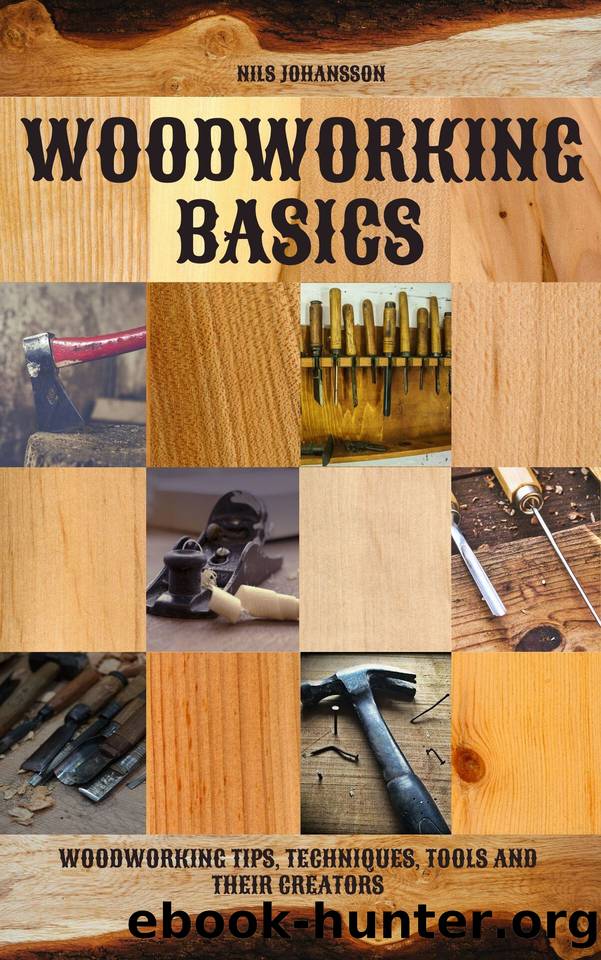Woodworking Basics: Woodworking Tips, Techniques, Tools and their Creators by NILS JOHANSSON & NILS JOHANSSON

Author:NILS JOHANSSON & NILS JOHANSSON [JOHANSSON, NILS]
Language: eng
Format: azw3
Published: 2020-05-05T16:00:00+00:00
Chapter 13 Shelter Building
When it comes to a shelter, it was a must for early pioneers in America. The colonists, including those of the Virginia plantations and the first Pilgrim contingent at Plymouth, initially made temporary, make-do shelters, which were in numerous instances merely caves dug into the ground or excavations in a sloping hillside.
Within a short time, however, they were constructing dwellings framed with hand-hewn oak timbers. The homes were simple in plan and design, and crude in workmanship; they were the expression of a fundamentally utilitarian approach to solving the problem of shelter with the available handcraft skills, tools, and woodland resources.
There was a plentiful supply of wood in the new land but a serious shortage of both handcraft skills and tools. Of the one hundred passengers who came on the Mayflower, over 40 were men.
The only one of them who was identified with a woodworking trade was a cooper, John Alden. He was a last-minute recruit, hired when the ship, en route from the port of Delftshaven, put in to Southampton for provisioning.
The dearth of men skilled in the building trades accounts in part for the primitive nature of the first dwellings of the early settlers. By 1624 sawyers, as well as a ship carpenter, had joined the Plymouth Plantation, but a shortage of craftsmen was a persistent issue.
In 1633 John Winthrop, Jr., the son of the governor of the Massachusetts Bay Company, was offering free passage to carpenters from London to induce them to migrate.
The shortage of tools was also a problem. In 1631 Governor Winthrop, writing to his son, then in London, of the main troubles and adversities of the struggling settlement, asked him to bring to the colony Chalk, and 2 or more of large Steele Compasses.
These tools would be used to mark and measure logs in hewing timbers, not only for new homes, but to replace those which, as Winthrop wrote, had been lost in fires.
Fires were a continuous problem, because chimneys of the houses were framed of wood and merely lined with dried mud or clay. A book written in 1634 to benefit the future Voyager to New England advised the emigrant to take all manner of Iron-wares, as all manner of nails for houses, all manner of tools for Workmen with Axes both broad and pitching-axes.
All manner of Augers, piercing bits, Whip-saws, Two-handed saws, Froes, both for the riving of Pailes and Laths, rings for Beetles heads, and Iron-wedges. These tools were being manufactured by blacksmiths in the settlements, but suggested that it would be advisable, nonetheless, to transport them.
This was a wise admonition, for tools remained in short supply throughout the colonial period. A house carpenter, as a contemporary English document indicates, would have used the whipsaw, a two-man, narrow-blade pit saw, axe, hatchet, adz, hammer, pincers, iron dog, which is a heavy iron staple for holding timbers in hewing, auger and spoke shave.
The documents of Governor Winthrop provide evidence not only of the importing of tools from England, but of their manufacture in the colonies.
Download
This site does not store any files on its server. We only index and link to content provided by other sites. Please contact the content providers to delete copyright contents if any and email us, we'll remove relevant links or contents immediately.
Life 3.0: Being Human in the Age of Artificial Intelligence by Tegmark Max(4507)
The Sports Rules Book by Human Kinetics(3588)
ACT Math For Dummies by Zegarelli Mark(3565)
The Age of Surveillance Capitalism by Shoshana Zuboff(3422)
Blood, Sweat, and Pixels by Jason Schreier(3130)
Unlabel: Selling You Without Selling Out by Marc Ecko(2981)
Urban Outlaw by Magnus Walker(2950)
Hidden Persuasion: 33 psychological influence techniques in advertising by Marc Andrews & Matthijs van Leeuwen & Rick van Baaren(2778)
The Pixar Touch by David A. Price(2739)
Bad Pharma by Ben Goldacre(2729)
Project Animal Farm: An Accidental Journey into the Secret World of Farming and the Truth About Our Food by Sonia Faruqi(2660)
Brotopia by Emily Chang(2591)
The Content Trap by Bharat Anand(2493)
Slugfest by Reed Tucker(2415)
The Airbnb Story by Leigh Gallagher(2370)
Kitchen confidential by Anthony Bourdain(2306)
Coffee for One by KJ Fallon(2007)
Smuggler's Cove: Exotic Cocktails, Rum, and the Cult of Tiki by Martin Cate & Rebecca Cate(1979)
Beer is proof God loves us by Charles W. Bamforth(1920)
